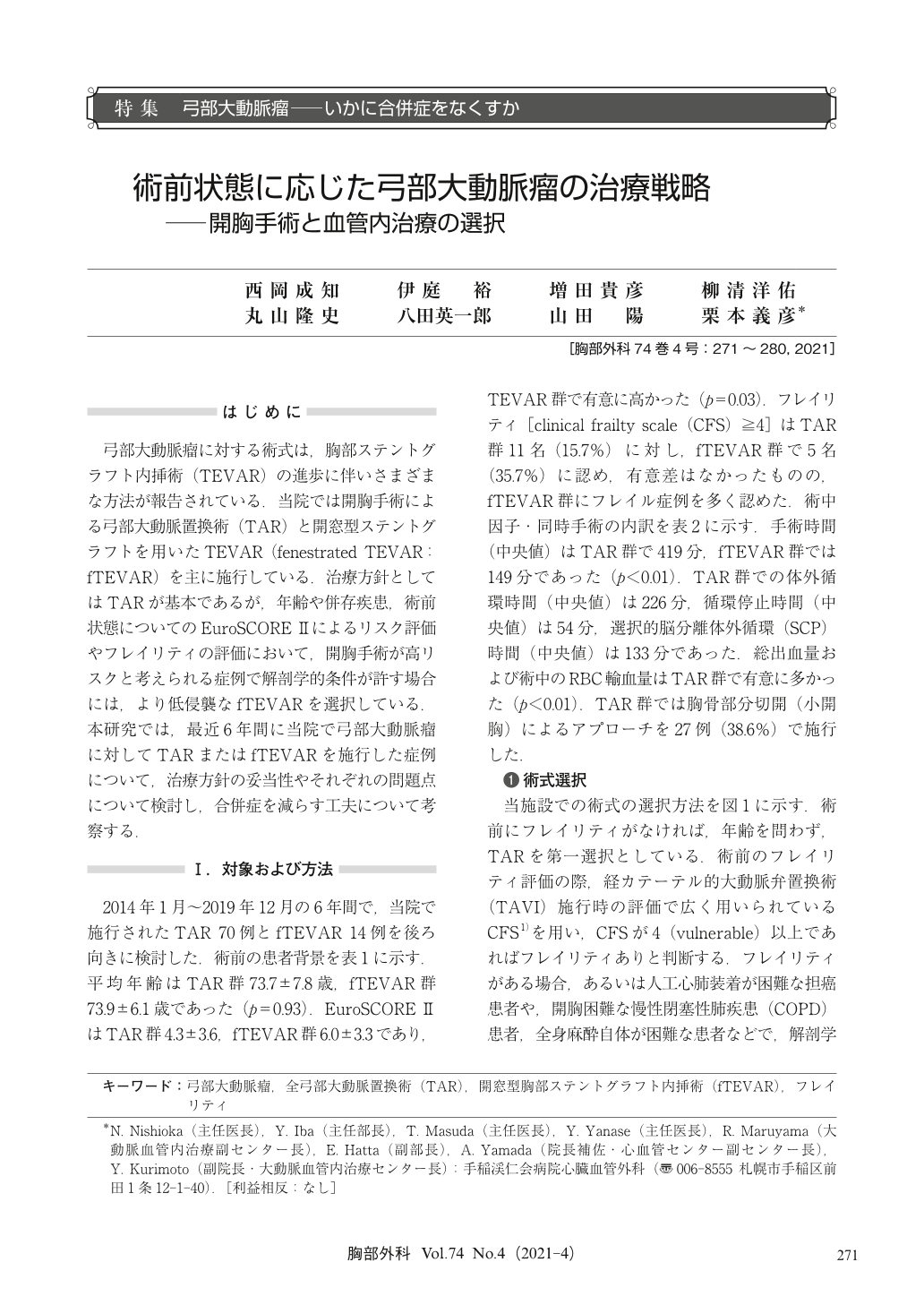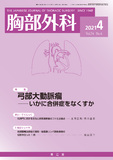Japanese
English
- 有料閲覧
- Abstract 文献概要
- 1ページ目 Look Inside
- 参考文献 Reference
- サイト内被引用 Cited by
弓部大動脈瘤に対する術式は,胸部ステントグラフト内挿術(TEVAR)の進歩に伴いさまざまな方法が報告されている.当院では開胸手術による弓部大動脈置換術(TAR)と開窓型ステントグラフトを用いたTEVAR(fenestrated TEVAR:fTEVAR)を主に施行している.治療方針としてはTARが基本であるが,年齢や併存疾患,術前状態についてのEuroSCOREⅡによるリスク評価やフレイリティの評価において,開胸手術が高リスクと考えられる症例で解剖学的条件が許す場合には,より低侵襲なfTEVARを選択している.本研究では,最近6年間に当院で弓部大動脈瘤に対してTARまたはfTEVARを施行した症例について,治療方針の妥当性やそれぞれの問題点について検討し,合併症を減らす工夫について考察する.
Objectives:We investigated the validity of the surgical strategy for aortic arch aneurysm depending on the patient’s condition.
Methods:Between 2014 and 2019, 70 patients underwent total arch replacement (TAR) and 14 patients underwent fenestrated thoracic endovascular aortic repair (fTEVAR) for aortic arch aneurysm. We selected the surgical strategy on the basis of the patient’s condition with or without frailty and if surgical risks including cancer or a respiratory condition precluded open surgery.
Results:The preoperative average ages were 73.3±7.8 years in the TAR group and 73.9±6.1 years in the fTEVAR group (p=0.93). EuroSCOREⅡ was 4.3±3.6 in the TAR group and 6.0±3.3 in the fTEVAR group (p=0.03). Frailty was observed in 11 patients (15.7%) in the TAR group and five patients (35.7%) in the fTEVAR group (p=0.08). In the fTEVAR group, there were three patients (21.4%) with cancer and three patients (21.4%) with a respiratory condition that precluded open surgery. The overall 30-day mortality rate was 0% for both groups, and the in-hospital mortality rate was 2.9% in the TAR group and 0% in the fTEVAR group (p=0.52). The incidence of stroke was 2.9% (two patients) in the TAR group and 7.1% (one patient) in the fTEVAR group (p=0.43). However, all stroke patients were able to walk at discharge. The cumulative survival rate was 88.9% and 83.5% in the TAR group and 85.1% and 68.1% in the fTEVAR group at two and five years, respectively (p=0.173). There were both 98.1% of patients in the TAR group and 85.7% and 75.0% of patients in the fTEVAR group who were free from reoperations at two and five years, respectively (p<0.01).
Conclusions:Our surgical strategy and outcomes for aortic arch aneurysm were generally appropriate. It is important to select open surgery or TEVAR depending on the patient’s condition.

© Nankodo Co., Ltd., 2021


